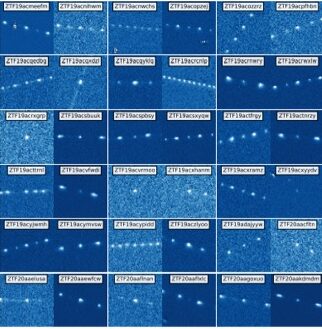Local Probes and Asteroids

Actual images with the Palomar 1.2-meter telescope and its ZTF survey showing glints from satellites. From Karpov & Peloton (2022).
VASCO is observing the Solar System for glints from unknown probes.
Some theories of the Milky Way Galaxy suggest that technological probes have been sent to stars to perform investigative functions, such as monitoring the local planets (Bracewell 1960,1973; Freitas 1980; Gillon 2014, Hippke 2020, 2021ab; Gertz 2018, 2021, Gertz & Marcy 2022). Traveling slower than 1% of light speed, probes could leisurely travel from one star to another. Upon arrival, a probe can be placed in orbit around the star or a planet. It can also land on an asteroid, able to investigative the planetary system for millions of years. Robotic interstellar probes may be purposely stealthy, equipped with telescopes, and communicating with a Galactic Internet – at the speed of light.
This hypothetical model predicts that some probes may currently reside in the Solar System, either in orbit around the Sun or around the Earth (Benford 2019, Gertz 2018, 2021). Stealth may be a priority for them. Still, we may search for probes located within the Solar System by detecting reflected light, which is difficult for the probes to prevent.
Probes may be detected by specular reflection of sunlight off any flat surfaces, as described by Lacki (2019) and Villarroel et al. (2022). Such ”glints” are momentarily brilliant because the reflected light is concentrated into a narrow beam equal to the angular size of the Sun, roughly ½ degree across for mirrors at 1 AU. Probes as stand-alone machines may glint making them momentarily detectable at the Earth. A rotating probe will repeatedly glint each rotation period, allowing independent astronomers to verify and study the probe.
Indeed, glints are commonly detected from satellites, as shown in Figure 1 (Karpov et al. 2017; Nir et al. 2021; Corbett et al. 2020, Karpov & Peloton 2022). The glints from satellites last for time scales of milliseconds to seconds, and the brightnesses at visual V band wavelengths are 5 to 13 mag. The theory of glints from machines in space was established by Lacki (2019) who derived the theory of glinting to predict their brightness and time scales, including the predicted hours-long “trains” of glints from their rotation. The duration of the glint is set by the rotational period of the probe and the angular size of the Sun (~0.5 deg). The periods of asteroids are known, but obviously not the periods of stand-alone probes.
